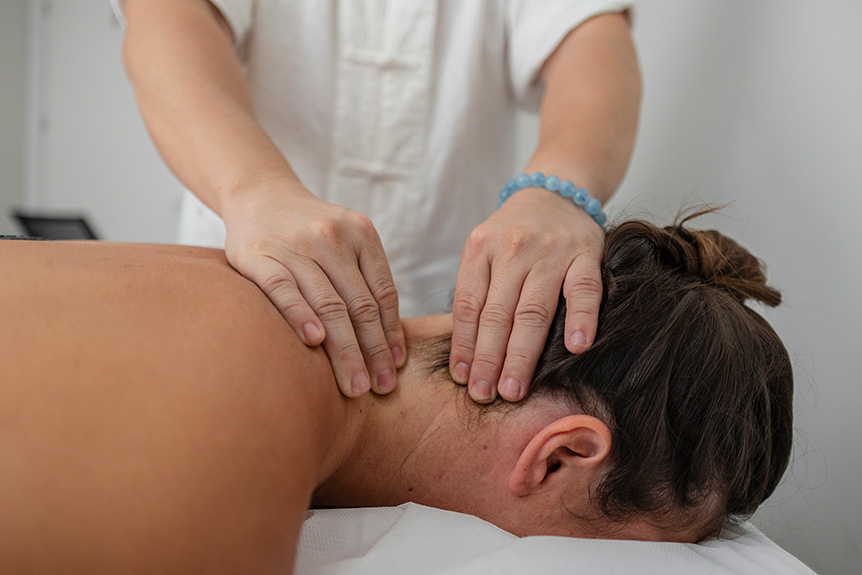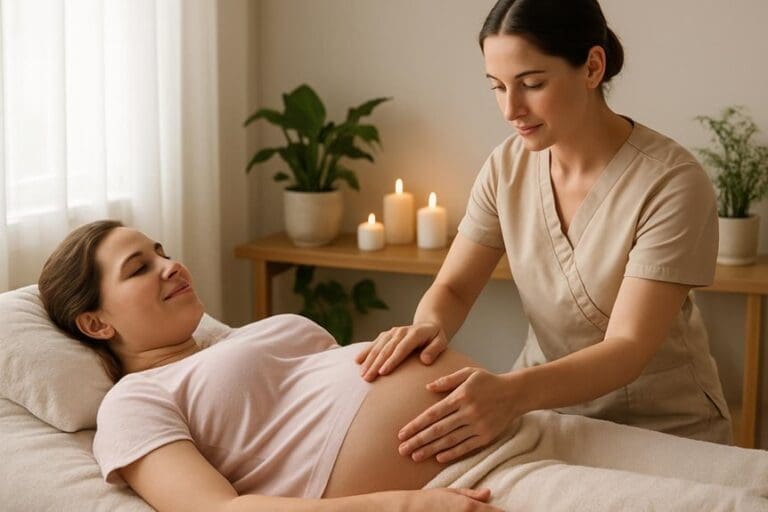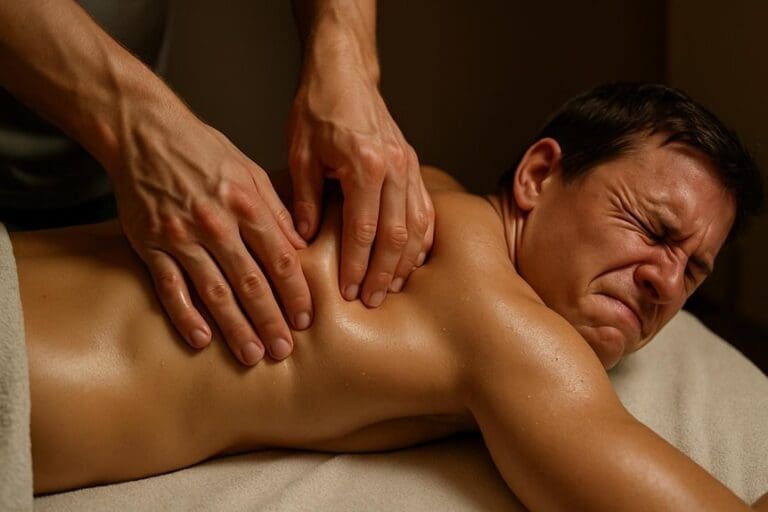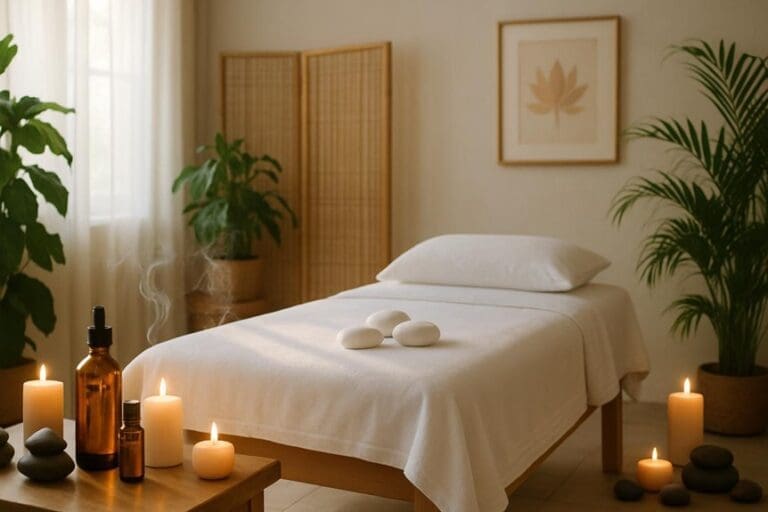Yes. It can cause brief dizziness in some people. Circulatory shifts, autonomic nervous system responses, and rapid release of muscle tension can unsettle balance. Dehydration, low blood pressure, medications, and standing quickly increase risk. Therapists minimise this by adjusting pressure, pacing, positioning, and guiding breathing, with a gradual cool-down and slow progression. If dizziness persists, is severe, or includes chest pain, fainting, vision changes, or weakness, seek medical advice. Practical steps and warning signs are outlined below.
Why Some People Feel Dizzy After Intensive Tissue Massage
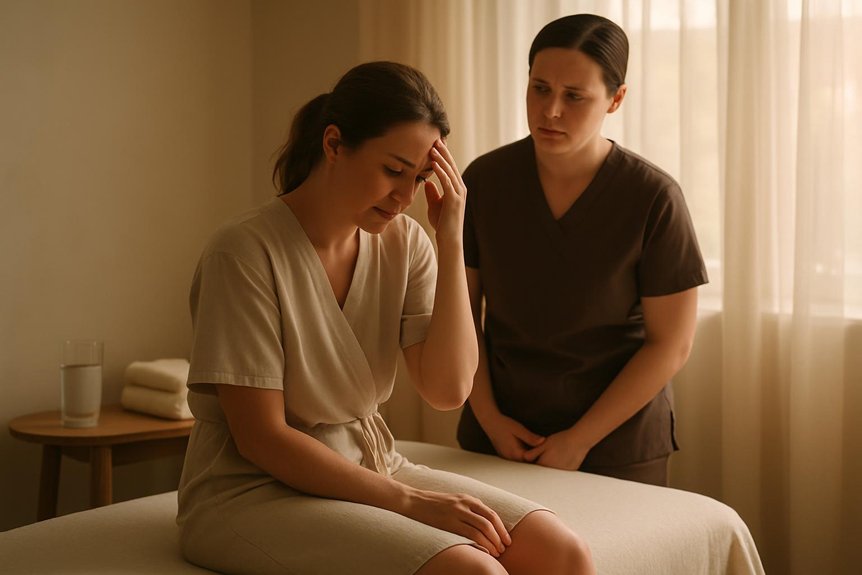
Although it is generally well tolerated, brief dizziness can occur as the body responds to pressure, circulatory shifts, and nervous system modulation. This response is typically short-lived and reflects the body recalibrating.
In Spa & Massage clinics, therapists apply progressively deeper techniques, allowing tissues and the autonomic nervous system to adapt without overwhelm. When intensity is adjusted gradually, clients often experience grounded clarity rather than lightheadedness.
Some individuals are more sensitive to rapid progressions—from lying face down to sitting up—or to the cumulative effect of sustained pressure on large muscle groups.
Therapists observe breathing, skin tone, and verbal feedback to pace sessions safely. They encourage unhurried repositioning, calm breathing, and a quiet moment before standing, restoring steadiness and preserving the treatment’s therapeutic gains. Additionally, the application of deep tissue massage techniques can offer benefits such as pain relief, improved mobility, and reduced tension, enhancing overall well-being when administered with care.
Common Triggers: Hydration, Blood Pressure, and Release of Tension
Building on the brief lightheadedness some clients report, three frequent contributors are hydration status, blood pressure changes, and the neuromuscular “release” that follows deep pressure.
Mild dehydration reduces circulating volume; when tissues are warmed and fluid shifts occur, the inner ear and brain may register that drop as dizziness. Blood pressure can also dip as the body moves from heightened tension to parasympathetic calm. Standing too quickly after a session may accentuate this orthostatic effect.
Finally, deep tissue techniques can liberate guarded muscles and fascial restrictions. The sudden easing of protective tone alters proprioceptive input, briefly unsettling balance.
At Spa & Massage in London, therapists observe these patterns daily and tailor pressure, pacing, and positioning with clinical care—prioritising comfort, steady passage, and attentive communication.
How We Minimise Dizziness During and After Your Session
From the moment a client checks in, Spa & Massage clinicians work to head off dizziness with simple, evidence-based steps. Intake screens for hydration status, recent meals, medications, and blood pressure patterns.
Therapists then select pressure, pacing, and positioning that support stable circulation—using slower progression, diaphragmatic breathing cues, and segmental work before deeper techniques. Neutral, hypoallergenic oils are applied sparingly to avoid excessive vasodilation.
Temperature is kept steady, with blankets offered to prevent post-treatment chills. Pillows elevate the chest slightly when needed, reducing orthostatic drops.
Sessions close with a gradual cool-down, gentle neck and ankle mobilisations, and coached side-lying before sitting. Water is provided, and therapists encourage a measured rise from the table.
Documentation guides continuity across our London clinics.
What To Do If You Feel Lightheaded Post-Massage
If lightheadedness occurs after a massage, immediate priorities are safety and steady circulation. Spa & Massage therapists advise sitting or lying down, keeping the head level with the heart, and breathing slowly—four seconds in, six out—for one to two minutes.
Hydration helps: sip cool water or an electrolyte drink. Gentle movement follows: flex and point the ankles, then rise gradually—sit, stand, pause, then walk. A small, protein‑rich snack can stabilise blood sugar.
They suggest avoiding hot showers, alcohol, or intense exercise for several hours, as heat and vasodilation may compound symptoms. Clients may rest in the lounge until fully steady; therapists will provide water and grounding stretches.
If lightheadedness recurs in future visits, therapists can adjust pressure, pacing, and positioning to support comfort.
When Dizziness Signals You Should Speak to a Therapist or GP
After immediate self-care for post-massage lightheadedness, certain patterns of dizziness warrant professional input. Persistent dizziness beyond 24–48 hours, episodes accompanied by fainting, chest pain, shortness of breath, severe headache, vision changes, new weakness, confusion, or heart palpitations should prompt urgent GP or NHS 111 advice.
Recurrent vertigo triggered by head movement may indicate vestibular issues; a GP assessment is appropriate. If dizziness follows neck work and feels sharp or unusual, especially with neurological symptoms, stop massage and seek medical review.
At Spa & Massage, therapists encourage clients to share symptoms before and after sessions. They adjust pressure, avoid provocative positions, and recommend hydration and slow progressions.
If concerning signs appear, they pause treatment, document findings, and guide clients to their GP—prioritising safety without judgment.
Conclusion
Dizziness after this massage can feel unsettling, yet it is usually a brief, normal response to shifts in circulation and the nervous system. Some may worry it signals harm; in most cases, it doesn’t. With tailored pressure, staged progressions off the table, and hydration guidance, clients typically regain steadiness quickly. Evidence-informed practice and therapist monitoring help identify when further advice is needed. Feeling heard and supported allows clients to pursue effective, comfortable treatment with confidence.
